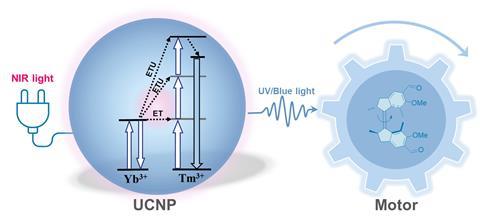In JACS, a team from Groningen and Amsterdam report that they were able to drive molecular motors with near-infrared light using upconverting nanoparticles for the first time.
Light-driven molecular motors are fascinating inventions, but they usually require either many substituents on the motor part or high-energy light (UV or blue) to make them rotate. However, this type of light does not have much penetrating power, which limits the practical use of the motors. However, Jinyu Sheng, Hong Zhang, Ben Feringa and their colleagues at the University of Amsterdam (UvA) and the University of Groningen (RUG) succeeded in using near-infrared (NIR) light for this purpose. The secret lay in upconverting nanoparticles (UCNPs).
‘We knew that UCNPs could be used to convert near-infrared light into UV or visible light, but this had never been attempted in motor systems before’, says Jinyu Sheng, who completed his PhD and postdoc in the Feringa group in Groningen and is now a professor at Soochow University in China. ‘We actually started the collaboration with Professor Zhang on a different project with a colleague, but we kept thinking that we should try using UCNPs for motors too.’
Unique
They knew it would work; they just had to find a suitable motor. ‘Earlier, we developed motor molecules that matched several of the requirements we were looking for’, Sheng continues. ‘We tried these, and lo and behold, the concept worked perfectly the first time!’ This means that you can use NIR to perform complicated motions with molecules that are very different from photoswitches. ‘It is something quite unique.’
Sheng stresses the ‘nice and successful collaboration’. ‘We were fortunate to find Professor Zhang, who provided high-quality nanoparticles developed by his PhD student.’ Hong Zhang, a professor of bionanophotonics at the University of Amsterdam (UvA), says that the challenge of this work was essentially matching the emitted and absorbed light. ‘The molecular motors should absorb sufficient light, while the energy transfer of the nanoparticles should be as high as possible. At the same time, the emitted light must be strong enough to power the motor rotation.’

Meat
Applications may be closer than you think. ‘We have already used the nanoparticles to treat cancer in an animal model’, says Zhang. ‘That means we can easily take the next step and include the motors, which can be adapted to perform a specific function. This work opens the way to all sorts of possibilities in biosystems.’
The researchers investigated whether NIR could pass through tissues such as meat while retaining enough energy to activate molecular rotation in solution. ‘Some initial attempts failed, probably because the meat was too thick’, says Sheng. As Sheng left the Netherlands shortly after graduating, the team were unable to conduct further trials. ‘If we had used a very thin slice of meat, I think it would have worked. But this is mostly proof-of-concept work, so there is a lot left to explore.’
Some of the remaining challenges are ensuring the energy transfer remains efficient in different media, particularly biological systems, which are more complicated than solutions. ‘Another challenge is finding a way to mix the motor and the nanoparticles more closely together to ensure energy transfer efficiency’, says Sheng. ‘Then, we have to design a system to see what the motor can do.’
Open doors
‘If you’re only concerned with light-driven motors, the doors are now open in photochemistry in biosystems’, says Zhang. ‘We’ve already demonstrated that we can ensure close proximity and energy efficiency.’ Zhang’s key message is that they have made a simple strategy available to use NIR to induce the interaction between sensitizing molecules and oxygen to induce the interaction between sensitizing molecules and oxygen to generate singlet oxygen in biosystems.













Nog geen opmerkingen